-
ORIGINAL ARTICLE
Excessive daytime sleepiness in nursing technicians: association with sleep quality and memory
Revista Brasileira de Enfermagem. 2024;77(3):e20230332
29/07/2024
Resumo
ORIGINAL ARTICLEExcessive daytime sleepiness in nursing technicians: association with sleep quality and memory
Revista Brasileira de Enfermagem. 2024;77(3):e20230332
29/07/2024DOI 10.1590/0034-7167-2023-0332
Visualizações0Ver maisABSTRACT
Objective:
to investigate excessive daytime sleepiness prevalence among nursing technicians and the association with sleep quality and memory.
Methods:
a cross-sectional, inferential study, carried out in a hospital unit in the state of Goiás between December 2020 and January 2021. Assessments were carried out using the Epworth Sleepiness Scale, the Pittsburgh Sleep Quality Index and the Prospective and Retrospective Memory Questionnaire, instruments validated for the Brazilian context. Bivariate and multivariate logistic regression analyzes were performed.
Results:
the sample consisted of 189 nursing technicians with a 40.9% excessive daytime sleepiness prevalence. In multivariate models, excessive daytime sleepiness was not associated with sleep quality, however there was a significant association with overall memory failures.
Conclusions:
study results demonstrate a high excessive daytime sleepiness occurrence, an association with overall memory failures and the need for psychosocial interventions for nursing technicians.
-
ORIGINAL ARTICLE
Nurses’ perspectives on nurses’ work methods
Revista Brasileira de Enfermagem. 2024;77(3):e20230374
29/07/2024
Resumo
ORIGINAL ARTICLENurses’ perspectives on nurses’ work methods
Revista Brasileira de Enfermagem. 2024;77(3):e20230374
29/07/2024DOI 10.1590/0034-7167-2023-0374
Visualizações0Ver maisABSTRACT
Objectives:
To analyze nurses’ perspectives on nurses’ work methods in the hospital context.
Methods:
A descriptive study with a qualitative approach was conducted in a hospital in northern Portugal, involving 17 nurses. Semi-structured interviews were used for data collection. Data collected between May and June 2023 underwent content analysis, supported by Atlas.ti software.
Results:
Three thematic areas emerged: “Nurses’ work methods in a hospital context,” highlighting the conception and components of work methods and the methods in use; “Implementation of nurses’ work methods,” emphasizing influencing factors and challenges to implementation; and “Impact of nurses’ work methods on patients, nurses, and institutions.”
Final Considerations:
Nurses’ work methods constitute the structure of nursing care. Some factors influence and some challenges arise in the implementation of these methods, producing impacts on patients, nurses, and institutions.

-
ORIGINAL ARTICLE
Evidence of validity of the Risk Self-Medication Questionnaire focused on Health Literacy
Revista Brasileira de Enfermagem. 2024;77(3):e20230386
29/07/2024
Resumo
ORIGINAL ARTICLEEvidence of validity of the Risk Self-Medication Questionnaire focused on Health Literacy
Revista Brasileira de Enfermagem. 2024;77(3):e20230386
29/07/2024DOI 10.1590/0034-7167-2023-0386
Visualizações0Ver maisABSTRACT
Objectives:
to analyze the validity evidence of the internal structure of the Risk Self-Medication Questionnaire Focused on Health Literacy.
Methods:
a psychometric study with 499 adults. The internal structure was assessed with exploratory and confirmatory factor analysis to prove the adjustment. Internal consistency was measured by composite reliability and McDonald’s omega coefficient (ω).
Results:
the parameters revealed a model of 35 items distributed across four factors, explaining 56% of the total variance, with factor loadings ranging from 0.31 to 0.85 and adequate communalities. Accuracy (0.79
Conclusions:
an instrument was obtained with good evidence of structural validity for measuring self-medication.
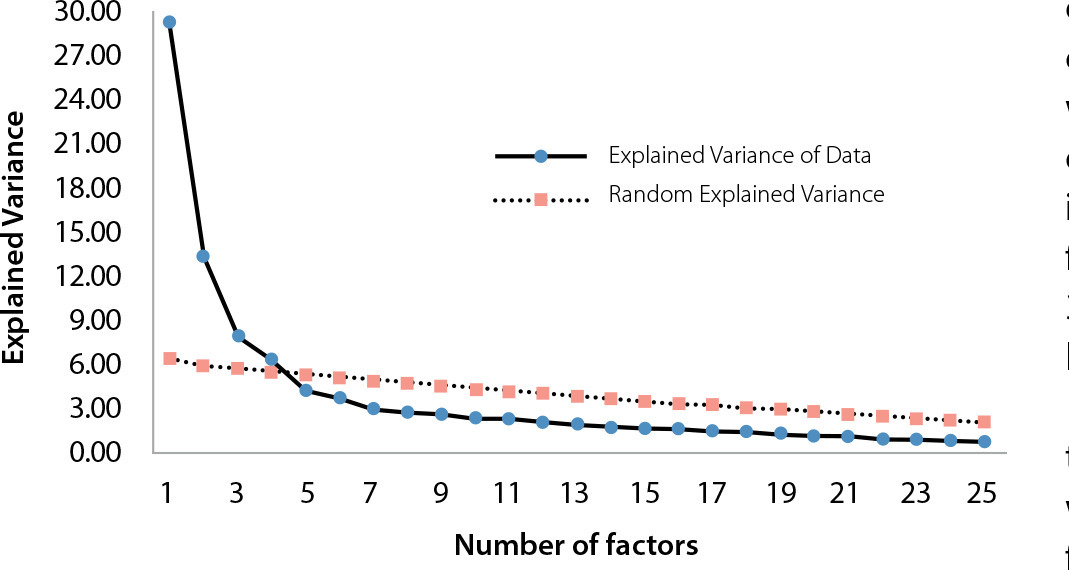
-
ORIGINAL ARTICLE
Nursing Process for institutionalized older adults: contributions from knowledge awareness workshop
Revista Brasileira de Enfermagem. 2024;77(3):e20230349
29/07/2024
Resumo
ORIGINAL ARTICLENursing Process for institutionalized older adults: contributions from knowledge awareness workshop
Revista Brasileira de Enfermagem. 2024;77(3):e20230349
29/07/2024DOI 10.1590/0034-7167-2023-0349
Visualizações0Ver maisABSTRACT
Objective:
To analyze the knowledge of professionals working in a Nursing Home about the Nursing Process before and after the awareness workshop.
Methods:
This is strategic action research, developed with nursing professionals and managers of a Nursing Home in Rio Grande do Sul, Brazil. Data were collected between January and June 2023, through semi-structured interviews before and after an awareness workshop. Discursive textual analysis of the data was carried out.
Results:
The central category “Understanding about the Nursing Process in Nursing Homes” emerged, which was unitized into two units of meaning and three categories of analysis.
Conclusion:
Data revealed non-use and lack of knowledge of the Nursing Process before awareness raising. Afterwards, a deeper understanding of the topic and its importance was identified. Awareness-raising workshops contribute to transformation of knowledge.
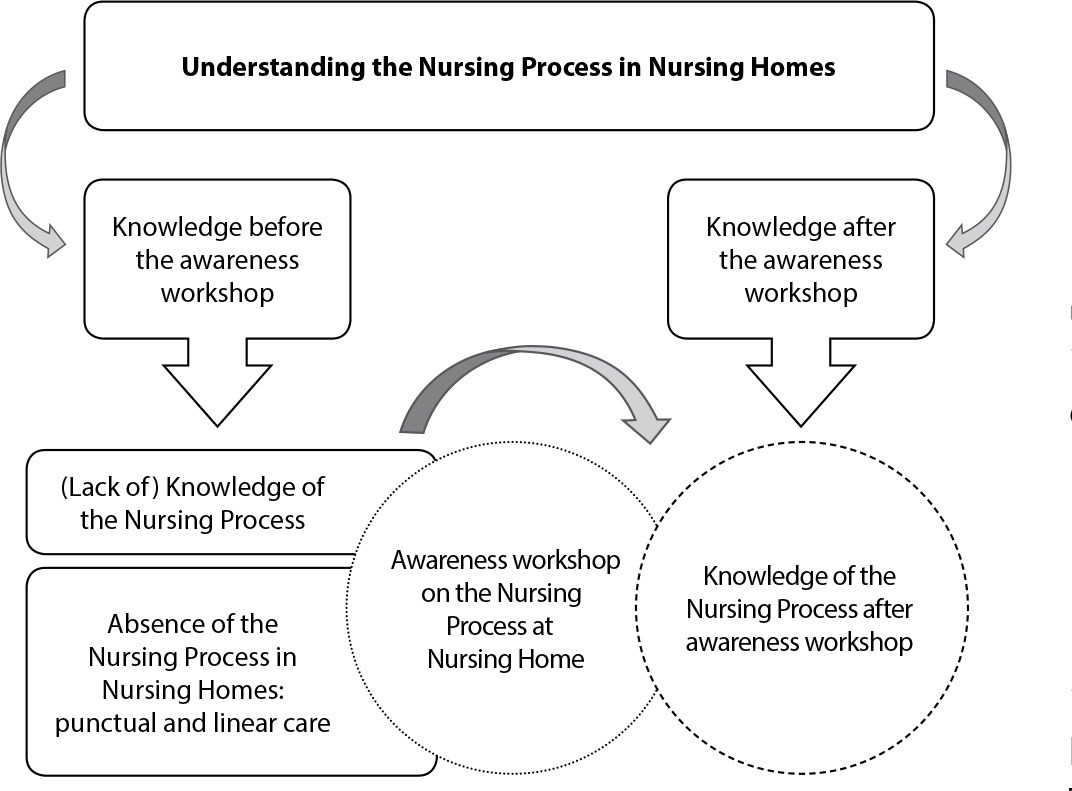
-
ORIGINAL ARTICLE
Fuzzy Logic: vulnerability of women who have sex with women to sexually transmitted infections
Revista Brasileira de Enfermagem. 2024;77(3):e20230271
29/07/2024
Resumo
ORIGINAL ARTICLEFuzzy Logic: vulnerability of women who have sex with women to sexually transmitted infections
Revista Brasileira de Enfermagem. 2024;77(3):e20230271
29/07/2024DOI 10.1590/0034-7167-2023-0271
Visualizações0ABSTRACT
Objective:
To describe the possibility of applying Fuzzy Logic in analyzing the vulnerability of Women Who Have Sex with Women to Sexually Transmitted Infections/HIV/AIDS.
Methods:
We developed a Fuzzy Logic system with 17 input variables and one output variable, using data related to vulnerability in a municipality located in the Midwest region of the State of São Paulo, Brazil.
Results:
The factor with the greatest positive impact was the confirmation that a low understanding of Sexually Transmitted Infections/HIV/AIDS is associated with higher vulnerability. Conversely, the statement “Not disclosing sexual activity to healthcare professionals,” where individuals do not admit to having sex with women, had the least impact.
Conclusions:
Fuzzy Logic facilitates the identification of vulnerability, expressed through the analysis of interaction between variables in each dimension. This makes it a promising method to assist in analyzing the vulnerability of specific populations.
Palavras-chave: Fuzzy LogicHealth VulnerabilityReproductive HealthSexually Transmitted DiseasesWomen Who Have Sex With WomenVer mais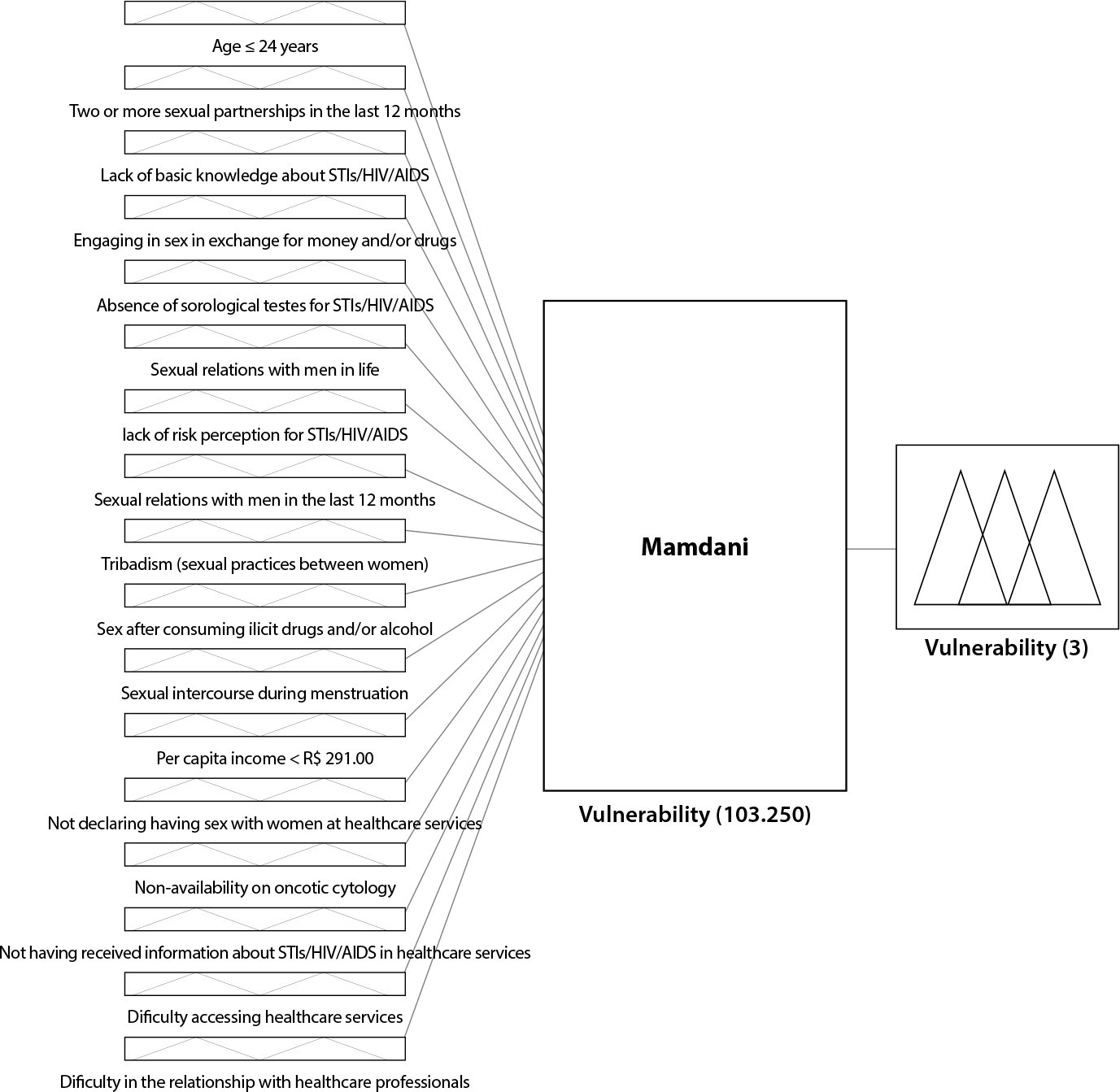
-
ORIGINAL ARTICLE
Evaluation of software technical quality for collecting data from patients under palliative care
Revista Brasileira de Enfermagem. 2024;77(3):e20230435
29/07/2024
Resumo
ORIGINAL ARTICLEEvaluation of software technical quality for collecting data from patients under palliative care
Revista Brasileira de Enfermagem. 2024;77(3):e20230435
29/07/2024DOI 10.1590/0034-7167-2023-0435
Visualizações0ABSTRACT
Objectives:
to evaluate software technical quality for collecting data from patients under palliative care.
Methods:
this is methodological technology evaluation research, according to the technical standard International Organization for Standardization/International Electrotechnical Commission 25040-2011, developed from August 2021 to August 2023. Eight nurses and eight information technology professionals participated as judges, who evaluated six quality characteristics and 23 subcharacteristics. Items that reached a percentage of agreement greater than 70% were considered suitable.
Results:
the characteristics evaluated by nurses/information technology professionals received the following percentages of agreement, respectively: functional suitability (94%-84%); reliability (100-70%); usability (89.9-66.8%); performance efficiency (95.8%-86.1%); compatibility (95.8-79.6%); and safety (96%-83.4%).
Conclusions:
the software was considered suitable in quality evaluation to offer support to nurses in collecting patient data under palliative care, with the potential to operationalize the first Nursing Process stage.
Palavras-chave: BiomedicalData CollectionNursing ProcessPalliative CareSoftwareTechnology AssessmentVer mais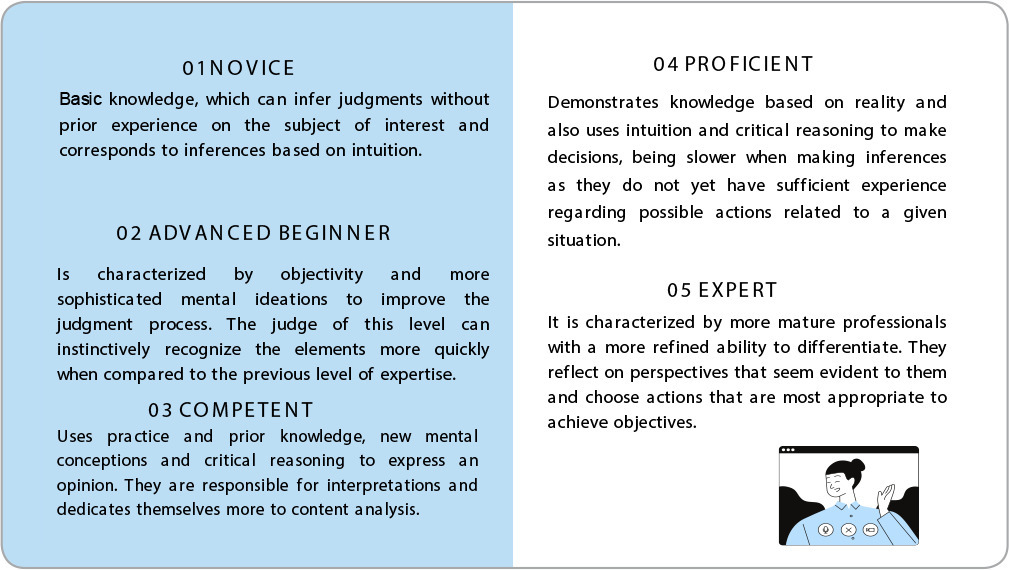
-
ORIGINAL ARTICLE
Family refusal of skin donation for transplantation: trends and associated factors
Revista Brasileira de Enfermagem. 2024;77(3):e20230209
29/07/2024
Resumo
ORIGINAL ARTICLEFamily refusal of skin donation for transplantation: trends and associated factors
Revista Brasileira de Enfermagem. 2024;77(3):e20230209
29/07/2024DOI 10.1590/0034-7167-2023-0209
Visualizações0Ver maisABSTRACT
Objectives:
to analyze the trends and factors associated with family refusal of skin donation for transplantation.
Methods:
this cross-sectional study was conducted in the State of São Paulo, with family authorization terms collected from 2001 to 2020. The variables analyzed included year, age, gender, cause of death, and type of institution. Data were analyzed using linear and multiple logistic regression, with the Odds Ratio estimated at p<0.05 for statistical significance.
Results:
1,355 individuals refused skin donation. The trend of refusals decreased between 2001 and 2009 in the age groups of 0-11 years and 12-19 years, but increased in the group aged ≥60 years. This trend continued to decrease in the 0-11 years group from 2010 to 2020, and increased in the 20-40 years group. Males and the age groups of 20-40 years, 41-59 years, and ≥60 years exhibited 27%, 34%, 47%, and 53% lower chances of refusal, respectively.
Conclusions:
there is an urgent need for measures to mitigate the high number of refusals associated with skin donation.
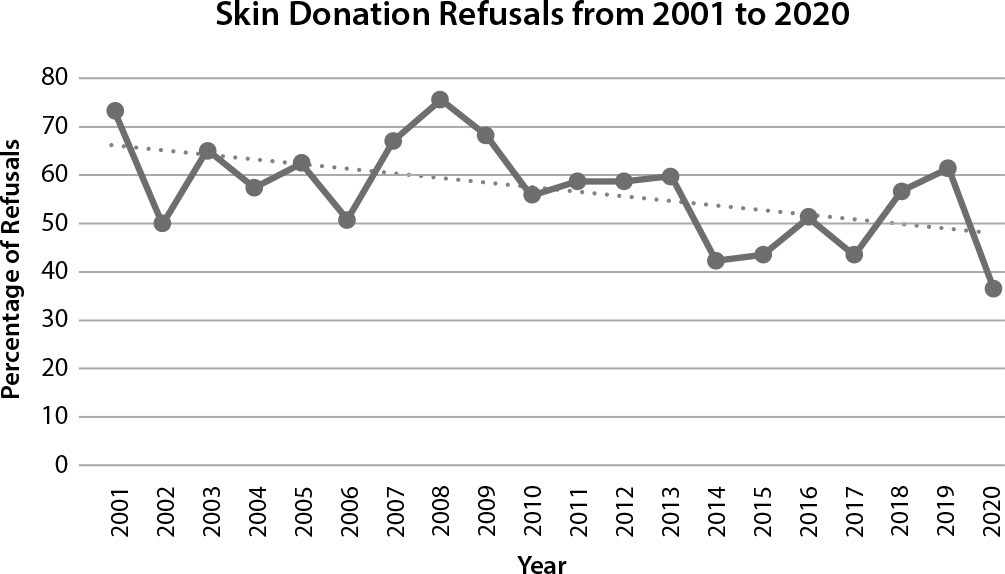
-
ORIGINAL ARTICLE
Educational technology for multidisciplinary training for managing waiting lists for elective patients
Revista Brasileira de Enfermagem. 2024;77(3):e20230299
29/07/2024
Resumo
ORIGINAL ARTICLEEducational technology for multidisciplinary training for managing waiting lists for elective patients
Revista Brasileira de Enfermagem. 2024;77(3):e20230299
29/07/2024DOI 10.1590/0034-7167-2023-0299
Visualizações0Ver maisABSTRACT
Objectives:
to construct and assess an educational technology for managing patient waiting lists for multidisciplinary training.
Methods:
study supported by Instructional Design – ADDIE model, whose stages of construction of educational technology were developed in the form of a multi-professional training course. Its respective content assessment was carried out by a committee of experts from 2021 to 2022. The analysis occurred based on the proportion of content adequacy with 95% Confidence Interval.
Results:
seventeen products were created as educational technology learning objects: five storyboards; four videos; three comic books; two pedagogical action plans; a mind map; and a YouTube® playlist. Nine experts assessed content adequacy, which reached 0.89.
Conclusions:
this educational technology contributes to the performance of professionals who manage waiting lists by reducing inequalities, alleviating differences, in addition to promoting equity in care and good health for patients in the Brazilian Health System.
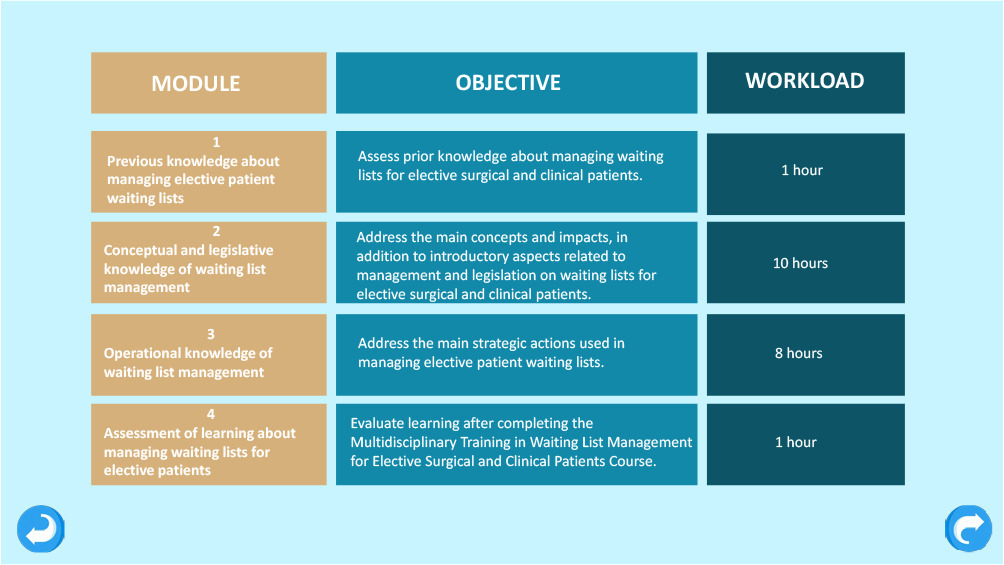
-
ORIGINAL ARTICLE
Desafios da prática na segurança do paciente
Revista Brasileira de Enfermagem. 2019;72(6):1504-1511
21/10/2019
Resumo
ORIGINAL ARTICLEDesafios da prática na segurança do paciente
Revista Brasileira de Enfermagem. 2019;72(6):1504-1511
21/10/2019DOI 10.1590/0034-7167-2018-0441
Visualizações0RESUMO
Objetivo:
compreender os desafios da prática profissional para o alcance das metas e objetivos do Programa Nacional de Segurança do Paciente.
Método:
estudo de caso qualitativo, fundamentado na Sociologia Compreensiva, realizado com 31 profissionais do Núcleo de Segurança do Paciente e da equipe de enfermagem, que trabalhavam em um hospital de ensino. A coleta de dados ocorreu entre maio e dezembro de 2015 por meio de entrevistas, observação e análise documental. A análise procedeu conforme as prerrogativas da Análise de Conteúdo.
Resultados:
emergiram três categorias, sendo elas: A realidade prescrita; Os recursos materiais e seus impactos no cuidado; e A realidade relacionada aos recursos humanos.
Considerações finais:
os desafios para a prática profissional segura perpassam pela estrutura física inadequada, insuficiência de recursos materiais e humanos, mas, principalmente, invadem a transição das mudanças no âmbito prescritivo para o real.
Palavras-chave: EnfermagemHospitaisPrática ProfissionalQualidade da Assistência à SaúdeSegurança do PacienteVer mais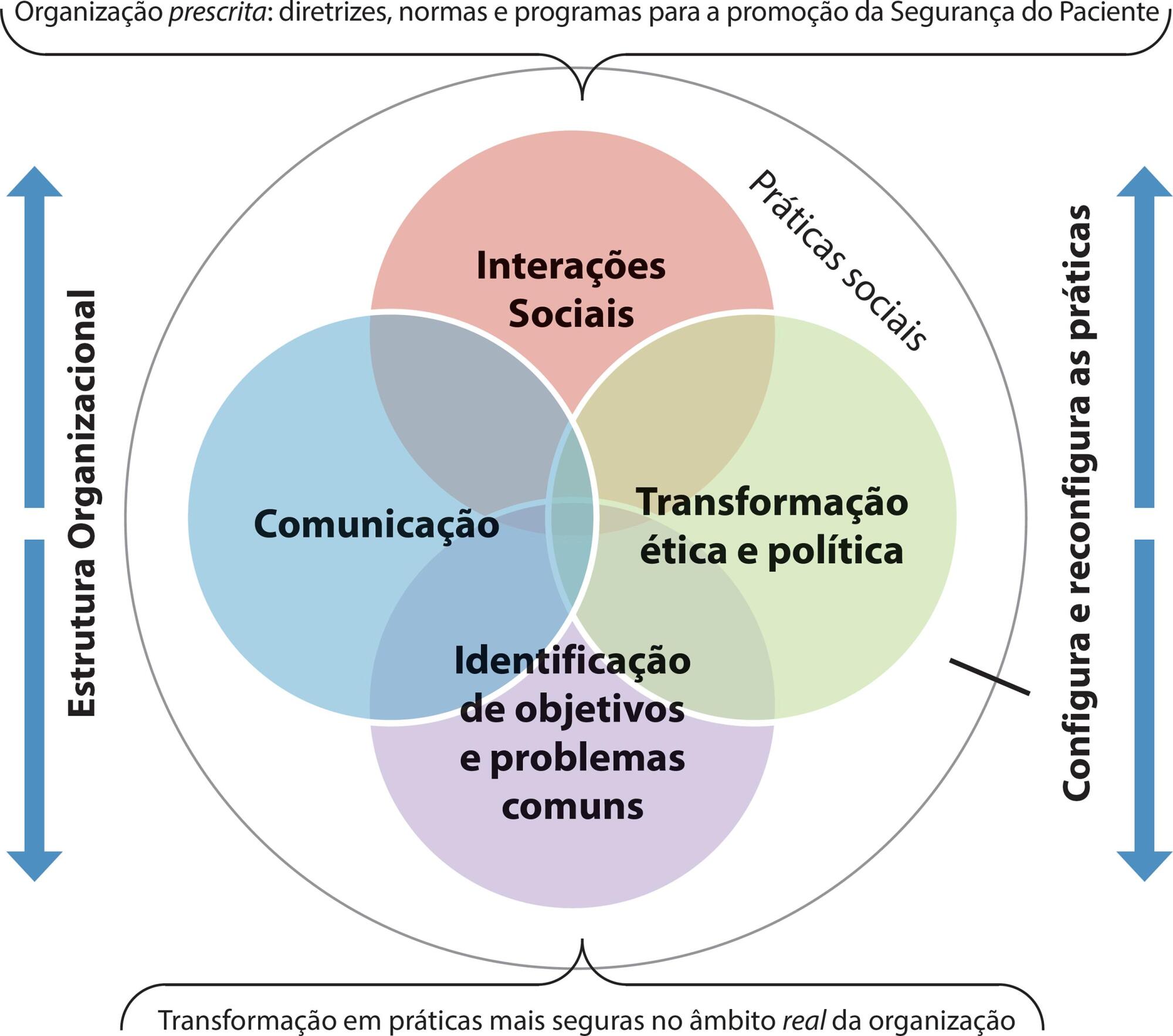
-
EDITORIAL
Monkeypox: between precision public health and stigma risk
Revista Brasileira de Enfermagem. 2022;75(5):e750501
01/08/2022
Resumo
EDITORIALMonkeypox: between precision public health and stigma risk
Revista Brasileira de Enfermagem. 2022;75(5):e750501
01/08/2022DOI 10.1590/0034-7167.2022750501
Visualizações0The World Health Organization (WHO) is on alert due to an unprecedented Monkeypox outbreak in non-endemic countries, such as Europe, which have been affected recently. Despite the low pandemic potential, the recent SARS-CoV-2 pandemic has contributed to heightened levels of public concern in the face of the threat of new global health emergencies().As of May […]Ver mais -
ORIGINAL ARTICLE
Clinical simulation in teaching Pediatric Nursing: students’ perception
Revista Brasileira de Enfermagem. 2020;73(2):e20180720
30/03/2020
Resumo
ORIGINAL ARTICLEClinical simulation in teaching Pediatric Nursing: students’ perception
Revista Brasileira de Enfermagem. 2020;73(2):e20180720
30/03/2020DOI 10.1590/0034-7167-2018-0720
Visualizações0Ver maisABSTRACT
Objectives:
to comprehend the perception of undergraduate nursing students about learning to care for the child and family through clinical simulation.
Methods:
this is a qualitative research conducted with ten nursing students through semi-structured interviews. Data were analyzed through content analysis.
Results:
data were organized into two categories: “learning a new way to learn,” in which students describe their experiences during the simulation, and “learning a new way to care,” in which they reflect on learning through simulation.
Final considerations:
we believe that clinical simulation practice in teaching should be encouraged because of the benefits it can offer to the students, faculty, patients and their families. However, we recommend further studies to validate scenarios of child and family healthcare.
-
ORIGINAL ARTICLE
Health literacy of adults with and without arterial hypertension
Revista Brasileira de Enfermagem. 2019;72(3):646-653
27/06/2019
Resumo
ORIGINAL ARTICLEHealth literacy of adults with and without arterial hypertension
Revista Brasileira de Enfermagem. 2019;72(3):646-653
27/06/2019DOI 10.1590/0034-7167-2018-0366
Visualizações0Ver maisABSTRACT
Objective:
Assess the level of health literacy of adults, with and without hypertension, treated in three basic health units (UBS) in Picos, Piauí.
Methods:
Cross-sectional study conducted with 357 adults. Data were collected using a questionnaire with sociodemographic variables, and literacy was assessed by the Test of Functional Literacy in Adults. Descriptive analysis was performed followed by the association between literacy and exposure variables with Pearson’s chi-squared (X2) test and Mann-Whitney U test.
Results:
Inadequate or marginal health literacy was found in three units investigated (71.5%; 77.8% and 85.2%);. Age and the years of schooling were factors associated with inadequate literacy in adults with hypertension (p<0.0001).
Conclusion:
Inadequate literacy was found in more than 70% of the hypertensive patients investigated. This finding reinforces the need to improve the self-care skills of hypertensive patients, especially the older ones and those with few years of schooling.
-
ORIGINAL ARTICLE
Efeito de vídeo educativo sobre cuidados ao recém-nascido no conhecimento de gestantes, puérperas e familiares
Revista Brasileira de Enfermagem. 2022;75:e20201371
10/11/2022
Resumo
ORIGINAL ARTICLEEfeito de vídeo educativo sobre cuidados ao recém-nascido no conhecimento de gestantes, puérperas e familiares
Revista Brasileira de Enfermagem. 2022;75:e20201371
10/11/2022DOI 10.1590/0034-7167-2020-1371
Visualizações0Ver maisRESUMO
Objetivos:
avaliar o efeito de vídeo educativo sobre cuidados ao recém-nascido para o aumento do conhecimento de gestantes, puérperas e familiares.
Métodos:
estudo quase experimental, com avaliação pré-intervenção e pós-intervenção com grupo único. Participaram 58 gestantes, puérperas e familiares atendidos em Unidades Básicas de Saúde e hospital no Ceará, Brasil. Para a análise, utilizaram-se os testes de McNemar e binomial.
Resultados:
após a intervenção, houve aumento na frequência de acertos, passando de 70,82% para 92,97%. A maioria das questões apresentou aumento significativo (p < 0,05) de acertos, com destaque para aspectos sobre: posição para dormir, secagem das roupas, livre demanda do aleitamento materno e o que deve ser evitado (como acessórios no local de dormir e talco na troca de fraldas).
Conclusões:
o vídeo educativo se mostrou eficaz na aquisição de conhecimentos pelos participantes nos cuidados aos recém-nascidos e pode auxiliar nas atividades de educação em saúde realizadas pelos enfermeiros.
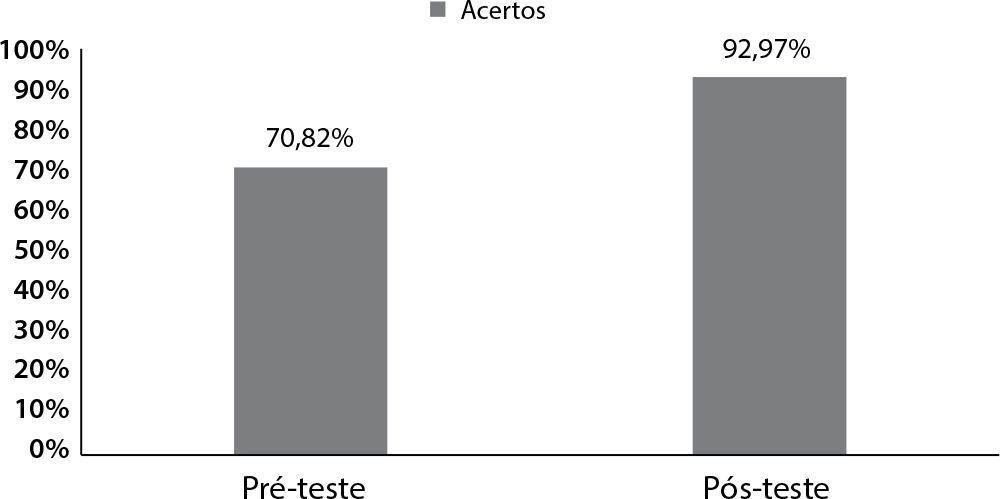
-
ORIGINAL ARTICLE
Inclusão digital e o uso da internet pela pessoa idosa no Brasil: estudo transversal
Revista Brasileira de Enfermagem. 2020;73:e20200241
06/11/2020
Resumo
ORIGINAL ARTICLEInclusão digital e o uso da internet pela pessoa idosa no Brasil: estudo transversal
Revista Brasileira de Enfermagem. 2020;73:e20200241
06/11/2020DOI 10.1590/0034-7167-2020-0241
Visualizações0Ver maisRESUMO
Objetivos:
Descrever o perfil de pessoas idosas brasileiras que utilizam a internet, o meio de acesso e a finalidade desse uso, e verificar a existência de associação entre variáveis sociodemográficas e aquelas relacionadas ao uso da internet.
Método:
Estudo transversal com idosos brasileiros usuários das redes sociais Facebook e WhatsApp, analisados de modo descritivo, uni e bivariado.
Resultados:
Participaram 384 idosos, em maioria mulheres (52,08%), com idade média de 64,6 anos e que utilizavam a internet para sanar dúvidas de saúde (65,36%). Principais atividades na internet foram ler, ouvir música, jogar, ver vídeos e fotos (37,30%). Principais benefícios apontados são interação (74,5%), aprendizado (19,2%) e entretenimento (19,25%). Houve diferenças estatísticas entre tempo de permanência conectado e variáveis sexo, idade e estado civil.
Conclusão:
Este estudo mostrou características de idosos que utilizam a internet, algo que desperta para possibilidade do uso de tecnologias digitais na otimização dos cuidados em saúde nessa população.
-
ORIGINAL ARTICLE
Transitional care from hospital to home for older people: implementation of best practices
Revista Brasileira de Enfermagem. 2020;73:e20200187
02/11/2020
Resumo
ORIGINAL ARTICLETransitional care from hospital to home for older people: implementation of best practices
Revista Brasileira de Enfermagem. 2020;73:e20200187
02/11/2020DOI 10.1590/0034-7167-2020-0187
Visualizações0ABSTRACT
Objective:
to assess the conformity of nursing care concerning best evidence in transitional care from hospital to home for older people.
Methods:
a project to implement best evidence based on the model proposed by the Joanna Briggs Institute in surgical clinic of a university hospital with older people, caregivers or family members, and nurses, between July and August 2019. Eight evidence-based criteria have been audited through interviews, medical records and computerized system, presented in percentages.
Results:
the highest non-compliance rate found in a baseline audit was absence of continued training on transitional care and hospital discharge plan. Identifying barriers to best practices included educational programs; afterwards, there was an improvement in compliance rates in all the criteria assessed.
Final considerations:
the criteria based on audited evidence showed an increase in compliance rates with the strategies implemented, contributing to improving transitional care for older people.
Palavras-chave: Continuity of Patient CareNursingPatient DischargePrimary Health CareTransitional CareVer mais
-
REVISÃO
Ambiente da prática de enfermagem na Atenção Primária à Saúde: revisão scoping
Revista Brasileira de Enfermagem. 2020;73(6):e20190479
14/08/2020
Resumo
REVISÃOAmbiente da prática de enfermagem na Atenção Primária à Saúde: revisão scoping
Revista Brasileira de Enfermagem. 2020;73(6):e20190479
14/08/2020DOI 10.1590/0034-7167-2019-0479
Visualizações0RESUMO
Objetivo:
Examinar a evidência científica acerca do ambiente da prática de enfermagem na Atenção Primária à Saúde.
Métodos:
Revisão scoping da literatura, com 3 etapas: 1) uma pesquisa inicial na CINAHL e MEDLINE; 2) uma pesquisa mais ampliada, utilizando as mesmas palavras-chave e termos de pesquisa, nas bases de dados restantes da plataforma EBSCOHost; 3) pesquisa nas referências bibliográficas dos artigos selecionados. Os estudos selecionados foram do período entre 2007 e 2018.
Resultados:
Foram incluídos 19 artigos; a maioria relatou achados do ambiente da prática de enfermagem e resultados para os clientes, para os enfermeiros, para os enfermeiros gerentes e para a eficiência das organizações, na Atenção Primária à Saúde.
Conclusão:
Melhorar o ambiente da prática de enfermagem tem consequências na qualidade dos cuidados de enfermagem, com aumento de resultados para os clientes, para a enfermagem e para a Atenção Primária à Saúde.
Palavras-chave: Administração de Serviços de SaúdeAmbiente de TrabalhoAtenção Primária à SaúdeEnfermagemRevisãoVer mais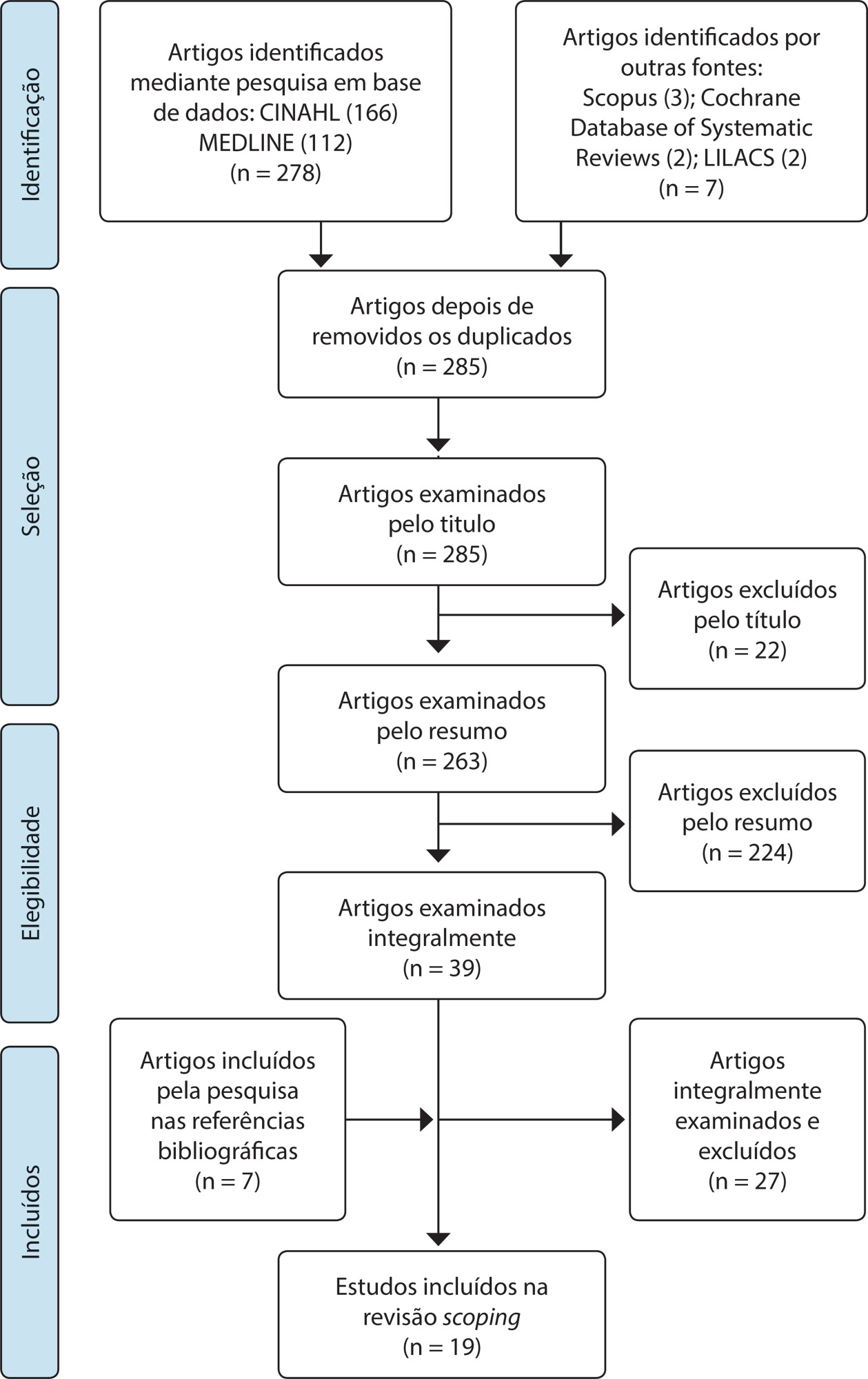
Búsqueda
Buscar en:
Nuvem de Tags
Adolescente (85) Atenção Primária à Saúde (239) COVID-19 (91) Criança (91) Cuidados de Enfermagem (269) Educação em Enfermagem (151) Educação em Saúde (139) Enfermagem (930) Enfermagem Pediátrica (86) Estudantes de Enfermagem (77) Estudos de Validação (131) Família (87) Idoso (208) Promoção da Saúde (99) Qualidade de Vida (104) Saúde do Trabalhador (86) Saúde Mental (145) Saúde Pública (82) Segurança do Paciente (150) Tecnologia Educacional (100)



